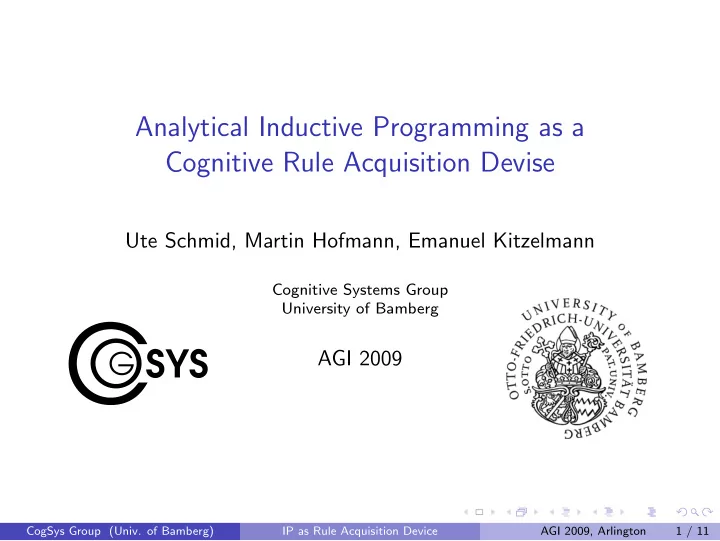

Analytical Inductive Programming as a Cognitive Rule Acquisition Devise Ute Schmid, Martin Hofmann, Emanuel Kitzelmann Cognitive Systems Group University of Bamberg AGI 2009 CogSys Group (Univ. of Bamberg) IP as Rule Acquisition Device AGI 2009, Arlington 1 / 11
Analytical Inductive Programming Inductive Programming (IP): Learning programs from incomplete specifications Programs: typically declarative, often functional Specifications: typically I/O examples Generate and Test approaches Analytical approaches: example-driven → detection of regularities in I/O examples guides generalization ֒ Intended application: Progamming-Assistance CogSys Group (Univ. of Bamberg) IP as Rule Acquisition Device AGI 2009, Arlington 2 / 11
Take a Broader Perspective Analytical IP provides a mechanism to extract generalized sets of recursive rules from small sets of positive examples of some desired behavior Domains where humans are typically exposed to positive examples only: ◮ language ◮ problem solving traces ◮ semantic relations 5 Are you hungry? 4 Yes, you are. Look, Billy is coming. 3 That is a very nice teddy. Animal 5 2 Mammal Fish 2 1 Dog Cat 1 3 4 Dachshund CogSys Group (Univ. of Bamberg) IP as Rule Acquisition Device AGI 2009, Arlington 3 / 11
From LAD to RAD Chomsky’s claim of a Language Acquisition Device Universal mechanism to extract grammar rules from language experience LAD is an inductive learning mechanism for recursive rule sets Grammar rules characterize linguistic competence and the systematicity, productivity and compositionality of language Analytical IP is an inductive learning mechanism for recursive rule sets with language as a special case → Analytical IP is a possible model for a general cognitive rule ֒ acquisition device We explore this proposition with Igor2 CogSys Group (Univ. of Bamberg) IP as Rule Acquisition Device AGI 2009, Arlington 4 / 11
Igor2 (again) Efficient induction of recursive rule sets from small sets of positive examples Can learn linear, tree, mutual recursive sets Performs necessary function invention Can consider background knowledge Restriction bias: functional recursive programs where outmost function is either non-recursive or provided by background knowledge Non-recursive classifier programs as special case (e.g., PlayTennis ) Preference bias: fewer case distinctions, most specific patterns, fewer recursive calls Can be applied to learning generalized rules in various cognitive domains, such as problem solving, reasoning, and natural language processing CogSys Group (Univ. of Bamberg) IP as Rule Acquisition Device AGI 2009, Arlington 5 / 11
Generalized Rules in Problem Solving The Tower Example Even small children learn very fast how to stack blocks in a given sequence No “stupid” strategies such as first put all blocks on the table and then stack them in the desired order but optimal strategy Igor2 learns Tower from 9 examples of towers with up to four blocks in 1.2 sec 5 4 3 5 2 2 1 1 3 4 CogSys Group (Univ. of Bamberg) IP as Rule Acquisition Device AGI 2009, Arlington 6 / 11
One of the 9 Examples eq Tower(s s table, ((s s s s table) (s table) table | , (s s s table) (s s table) table | , nil)) = put(s s table, s table, put(s s s table, table, put(s s s s table, table, ((s s s s table) (s table) table | , (s s s table) (s s table) table | , nil)))) Examples are equations with the given state specified in the head and the optimal action sequence (generated by a planner) as body additionally: 10 corresponding examples for Clear and IsTower predicate as background knowledge CogSys Group (Univ. of Bamberg) IP as Rule Acquisition Device AGI 2009, Arlington 7 / 11
Generalized Tower Rule Set Tower(O, S) = S if IsTower(O, S) Tower(O, S) = put(O, Sub1(O, S), Clear(O, Clear(Sub1(O, S), Tower(Sub1(O, S), S)))) if not(IsTower(O, S)) Sub1(s(O), S) = O . Put the desired block x on the one which has to be below y in a situation where both blocks are clear and the blocks up to the block y are already a tower. CogSys Group (Univ. of Bamberg) IP as Rule Acquisition Device AGI 2009, Arlington 8 / 11
Learning from Positive Experience RAD in Action Solve some problems of a domain using a search-based strategy (e.g. planning), observe regularities in the problem solving traces and generalize over them For future problems of this domain: application of the learned rules (no need to search anymore = expertise) → Learning is more than chunking or updating strengthes ֒ → Learning as acquisition of new problem solving schemes ֒ Further examples; Clearblock (4 examples,0.036 sec) Rocket (3 examples, 0.012 sec) Tower of Hanoi (3 examples, 0.076 sec) CogSys Group (Univ. of Bamberg) IP as Rule Acquisition Device AGI 2009, Arlington 9 / 11
Learning a Phrase-Structure Grammar (Learning rule sets for reasoning, e.g. transitivity of ancestor , isa ) Learning rules for natural language processing: e.g. a phrase structure grammar 1: The dog chased the cat. 2: The girl thought the dog chased the cat. 3: The butler said the girl thought the dog chased the cat. 4: The gardener claimed the butler said the girl thought the dog chased the cat. S → NP VP NP → d n VP → v NP | v S CogSys Group (Univ. of Bamberg) IP as Rule Acquisition Device AGI 2009, Arlington 10 / 11
Wrapping Up Human learning is amazingly powerful This power is only partially covered by typical machine learning approaches Chunking rules and manipulating rule strengthes (as used in cognitive architectures) is not enough: models a cognitive system where all strategic knowledge is already available and only its application needs to be optimized Analytical IP provides a mechanism to model acquisition of sets of recursive rules Such rules represent problem solving schemes/strategies which are induced from experience CogSys Group (Univ. of Bamberg) IP as Rule Acquisition Device AGI 2009, Arlington 11 / 11
Recommend
More recommend